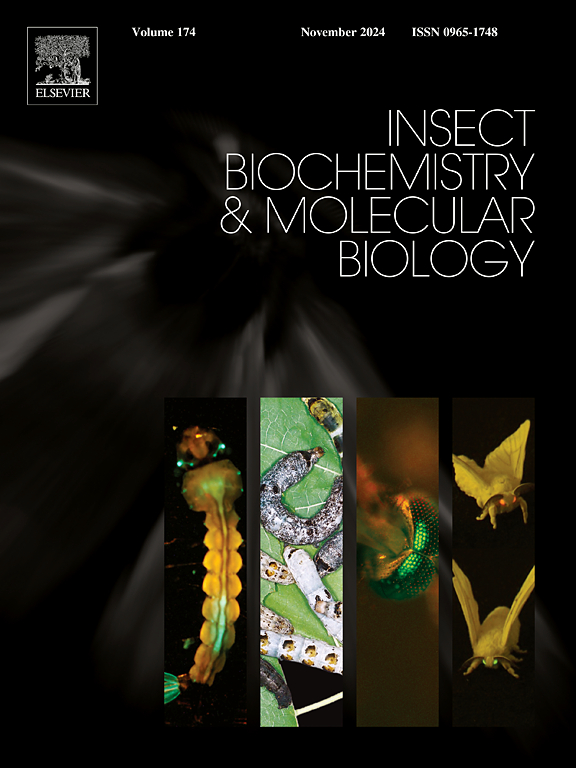Doublesex knockout via CRISPR/Cas9 disrupts fertility and sexual dimorphism of wings in the rice stem borer, Chilo suppressalis
IF 3.7
2区 农林科学
Q2 BIOCHEMISTRY & MOLECULAR BIOLOGY
引用次数: 0
Abstract
The doublesex (dsx) gene has a conserved role in sex determination in insects, controlling sexual development and mating behavior. Although dsx is known to participate in these critical functions, its role in insect sex determination remains not fully elucidated. Given the economic importance of the rice pest Chilo suppressalis, we employed this species as a model to investigate the function of its dsx homolog. We cloned and characterized the Csdsx gene, which is 1123 bp in length and encodes four sex-specific proteins: three female-specific isoforms of 252, 258, and 254 amino acids, respectively, and one male-specific isoform of 290 amino acids. Phylogenetic analysis revealed that Csdsx is highly conserved within Lepidoptera, containing two domains: DM DNA binding domain and DSX dimer domain. Analysis of transcripts produced from a mini-dsx construct transfected into human HEK293T cells indicates that the female-splicing pattern is the default mode. Quantitative real-time PCR showed that among various developmental stages, Csdsx expression peaked at the first instar larval stage and showed tissue-specific, stage-dependent patterns, with notably high levels in the larval midgut, pupal fat body, and adult thorax in both sexes. In comparison to wild-type (WT) adults, Csdsx-knockout individuals exhibited malformations in their external genitalia, and female wing patterns became masculinized. Dissections revealed that knockout females had a reduced number of mature oocytes, while knockout males displayed a smaller testis area. Furthermore, when Csdsx-knockout females were paired with wild-type males, their mating behavior was significantly impaired. RNA-seq revealed that Csdsx disruption led to sex-biased gene expression shifts, including upregulation of male-associated genes (e.g., OBPs, PBPs, trypsin) and downregulation of female-specific genes (vitellogenin, FAS), indicating partial masculinization at the transcriptional level. These findings underscore the critical role of the dsx gene in reproductive development and sexual dimorphism in C. suppressalis.

通过CRISPR/Cas9基因敲除双性基因会破坏水稻茎秆螟虫(Chilo suppressalis)的繁殖能力和翅膀的两性二态性
双性基因(dsx)在昆虫性别决定中起保守作用,控制着性发育和交配行为。虽然已知dsx参与这些关键功能,但其在昆虫性别决定中的作用尚未完全阐明。鉴于水稻害虫Chilo suppressalis的经济重要性,我们以该物种为模型研究其dsx同源基因的功能。我们克隆并鉴定了Csdsx基因,该基因长度为1123 bp,编码4种性别特异性蛋白:分别包含252、258和254个氨基酸的3种女性特异性异构体,以及290个氨基酸的1种男性特异性异构体。系统发育分析表明,Csdsx在鳞翅目中具有高度保守性,包含DM DNA结合域和DSX二聚体域两个结构域。对转染人HEK293T细胞的mini-dsx构建物产生的转录本的分析表明,女性剪接模式是默认模式。实时荧光定量PCR结果显示,在不同发育阶段,Csdsx的表达在1龄幼虫阶段达到峰值,并表现出组织特异性和阶段依赖性,在雌雄幼虫中肠、蛹脂体和成虫胸腔中表达水平均较高。与野生型(WT)成虫相比,csdsx基因敲除个体的外生殖器出现畸形,雌性翅膀模式变得男性化。解剖显示,基因敲除的雌性成熟卵母细胞数量减少,而基因敲除的雄性睾丸面积较小。此外,当csdsx基因敲除的雌性与野生型雄性配对时,它们的交配行为显著受损。RNA-seq显示,Csdsx的破坏导致性别偏倚的基因表达变化,包括男性相关基因(如OBPs、PBPs、胰蛋白酶)的上调和女性特异性基因(卵黄蛋白原、FAS)的下调,表明在转录水平上部分男性化。这些发现强调了dsx基因在C. suppressalis的生殖发育和性别二态性中的关键作用。
本文章由计算机程序翻译,如有差异,请以英文原文为准。
求助全文
约1分钟内获得全文
求助全文
来源期刊
CiteScore
7.40
自引率
5.30%
发文量
105
审稿时长
40 days
期刊介绍:
This international journal publishes original contributions and mini-reviews in the fields of insect biochemistry and insect molecular biology. Main areas of interest are neurochemistry, hormone and pheromone biochemistry, enzymes and metabolism, hormone action and gene regulation, gene characterization and structure, pharmacology, immunology and cell and tissue culture. Papers on the biochemistry and molecular biology of other groups of arthropods are published if of general interest to the readership. Technique papers will be considered for publication if they significantly advance the field of insect biochemistry and molecular biology in the opinion of the Editors and Editorial Board.

 求助内容:
求助内容: 应助结果提醒方式:
应助结果提醒方式:


